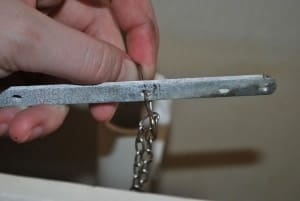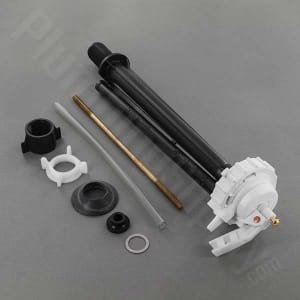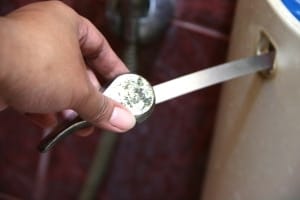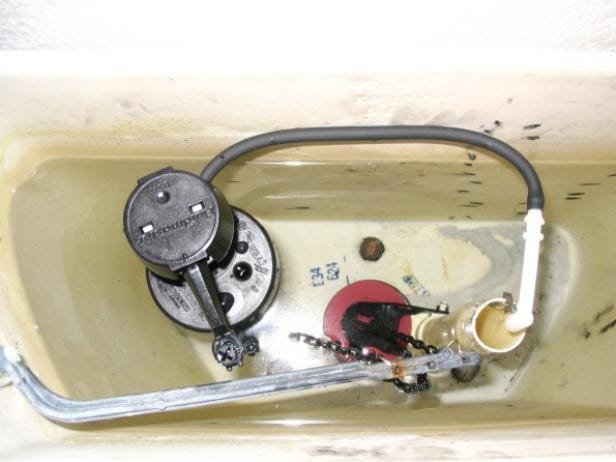Flushing Away the Issue: How to Stop a Running Toilet
In this our next series of helpful “at-home” plumbing tips, we will address how to deal with various toilet issues. In many cases, simple monitoring and staying on top of toilet maintenance can help to avoid any major problems. For our first article in the series, we will go through a series of steps to help you Stop a Running Toilet.
When addressing how to Stop a Running Toilet, there are several points and parts of the toilet that you will want to look at. In doing this troubleshooting, you can find the source of this annoyance and get on fixing it before it turns costly. Luckily, not only is finding the source of the problem somewhat easy but in most cases, the fix is a simple one too.

The problem with your running toilet may just be that the flapper chain is too short or too long.
What Exactly Does it Mean When My “Toilet is Running?”
Before troubleshooting, it makes sense that you are sure you know what is going on in the case your “toilet is running.” While you may know this, it certainly does not hurt to review.
To start, after you flush your toilet, water fills into the tank. As this happens, the water lifts a float that will shut the water off after it reaches the proper level. Likewise, there is a lever that will open the toilet’s flapper, causing the actual flush. The flapper then falls back into place when the water level goes down. This process can be interrupted, causing the toilet to keep running for several different reasons that leave the bowl unfilled following a flush and in some cases still running.
As noted above, typically one of four factors are going to play into how you can Stop a Running Toilet. With a thorough check for each, the issue can be narrowed down to reveal the problem.
Common Possible Problem Areas to Address to Stop a Running Toilet
- Flapper Seal or Flush Valve
- Flapper Chain
- Leaky Fill Valve
- Old or Corroded Toilet Handle
Start with the Seal and Valve to Stop a Running Toilet

Troubleshooting your toilet’s fill valve and its parts may result in you being able to Stop a Running Toilet.
The first area to check in the instance of a running toilet is the flapper seal or flush valve. For older model toilets, there is a chain and flapper seal. On the contrary, for newer units, there is a flush valve. These three parts in one as compared to what is seen with the older models. These three parts are the flapper seal, overflow valve, and the actual flushing mechanism.
Whether you have a brand new toilet or the same one for years, the seal eventually can become old and warped. When a seal is compromised, the water flow from the tank to the bowl becomes prohibited. The universally known way to check if you need to replace a flapper seal or flush valve is one involving food coloring.
Yes, food coloring…Anyhow, you simply put a few drops of your food coloring into the water in your toilet’s tank. Then, after waiting a few minutes, simply check the toilet bowl. If upon checking, you see the water has become colored in the bowl without flushing, this means you will need to replace the flapper seal or flush valve to Stop a Running Toilet.
The “Too Long…or Too Short” of it. Checking the Flapper Chain
The next point that we want to check, to Stop a Running Toilet is the flapper chain. Like our check on the seal and valve, there are a few things to look for here. First, when your toilet was initially installed, the chain may have simply been too long or short. This would cause the flapper seal in some way to not close properly.
If your chain is too short, the seal will not shut and will allow water to run continuously. Consequently, if the chain is too long, it could also get in the way of the seal closing and prevent it from forming a watertight seal. Again to restate, this can be an easy fix for you. All you need to do to Stop a Running Toilet, in this case, is adjust the chain to proper functioning length.
Give Your Handle a Lift to Check for a Leak
The third possibility that may need to be addressed to Stop a Running Toilet is a leak in your fill valve. As with our earlier discussed issues, this could cause your toilet to run continuously.
To see if this is the issue, first, flush your toilet. Once you’ve flushed, lift the toilet’s flush arm while the tank is still refilling. This will stop the water flow if all is working correctly. If the water does keep flowing and starts pouring into the overflow valve, then this is your problem. To Stop a Running Toilet in this case, you will need to replace the fill valve, as this shows it leaks.
Whether You Loosen or Replace, a Sticky Handle Needs Fixing

If a toilet handle is tight, loosening may work, but a corroded handle must be replaced.
The last part that we will troubleshoot to Stop a Running Toilet is the toilet handle. When checking the handle, again begin with a regular flush. If upon flushing, you notice the handle staying down instead of moving back into place, we have an issue.
The issue with your toilet handle, in this case, is that it is either old, corroded, or just stiff. Regardless, any of those three scenarios call for a fix, as the entire time a handle is in that down position, the toilet is running. To Stop a Running Toilet by fixing the handle, first, try loosening it. If it no longer sticks after flushing, you’re good to go. If loosening does not help, you will need to take a closer look and simply replace any parts that have become corroded.
Done Troubleshooting and Still Didn’t Stop a Running Toilet…Give Us a Call
If you have completed an “at home” walk through each of these possibilities and not found the problem, give us a call! The number one name in Raleigh area plumbers, Poole’s Plumbing will come out, diagnose and fix the issue. Once and for all, one way or another we will help you Stop a Running Toilet! For more plumbing tips or to contact Poole’s Plumbing about taking care of your plumbing needs, visit poolesplumbing.com.




